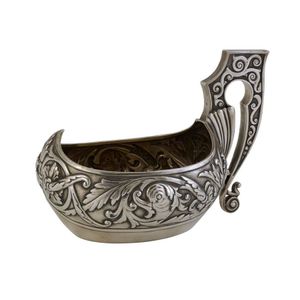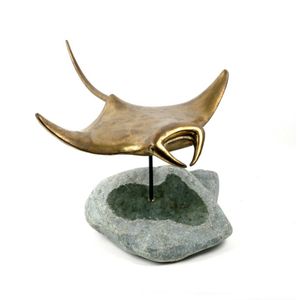Art Nouveau Bronze Figural Serving Tray
You must be a subscriber, and be logged in to view price and dealer details.
Subscribe Now to view actual auction price for this item
When you subscribe, you have the option of setting the currency in which to display prices to $Au, $US, $NZ or Stg.
- Circa - A Latin term meaning 'about', often used in the antique trade to give an approximate date for the piece, usually considered to be five years on either side of the circa year. Thus, circa 1900 means the piece was made about 1900, probably between 1895 and 1905. The expression is sometimes abbreviated to c.1900.
- Art Nouveau Period - The Art Nouveau period was a cultural movement that emerged in the late 19th century, and was characterized by its emphasis on natural forms, flowing lines, and a decorative, ornamental style. Art Nouveau was a reaction against the ornate and heavily stylized designs of the previous era, and sought to create a new, more organic aesthetic.
Art Nouveau was characterized by its use of sinuous, curving lines, as well as a focus on natural elements such as flowers, vines, and other organic shapes. Art Nouveau designers sought to create a total work of art, in which every element of a building or object was designed to be harmonious with the overall design.
Some of the most iconic examples of Art Nouveau design include the Paris Metro entrances designed by Hector Guimard, the works of the artist Alphonse Mucha, and the architecture of Victor Horta in Brussels.
The Art Nouveau period was at its peak between 1890 and 1910, but began to decline in popularity by the start of World War I. However, Art Nouveau remains an important influence on design and art to this day, and continues to be celebrated for its emphasis on natural forms and decorative style. - Bronze - An alloy of copper and tin, traditionally in the proportions of about 9 parts of copper to 1 part of tin.
The discovery of bronze in Western Asia in the 4th century enabled people to create metal objects which were superior to those previoulsy possible because of its strength and hardness, and it has been used throughout the world for weapons, coins, tools, statuary and other decorative items.
It is very fluid in a molten state, and its hardness, strength when set, and non-corrosive properties makes it most suitable for casting sculpture.
This item has been included into following indexes:
Visually similar items

A Russian silver kovsh, marks for Grachev Bros, Moscow, 1885, the sides embossed with elaborate interlocking scrolling foliate motifs to stipled background, the handle with scrolls in relief and terminating in a scroll, Cyrillic maker's mark to base and as

A brass and serpentine manta ray sculpture, with wings outstretched and long tail supported on a steel rod to a serpentine base with part polished top. Width 39.5 cm, height 28 cm

A bronze figurine of a lotus lady, after Milo, in the Art Nouveau manner and depicting a sinuous young woman standing on a lotus leaf holding a lotus flower bud, a large open flower at her feet, upon a black oval marble base; incised signature of Milo to b

A Chinese carved boxwood Yaksa, yecha, the semi-god poised for combat, holding a trident in his hands, riding waves, 38 cm high
